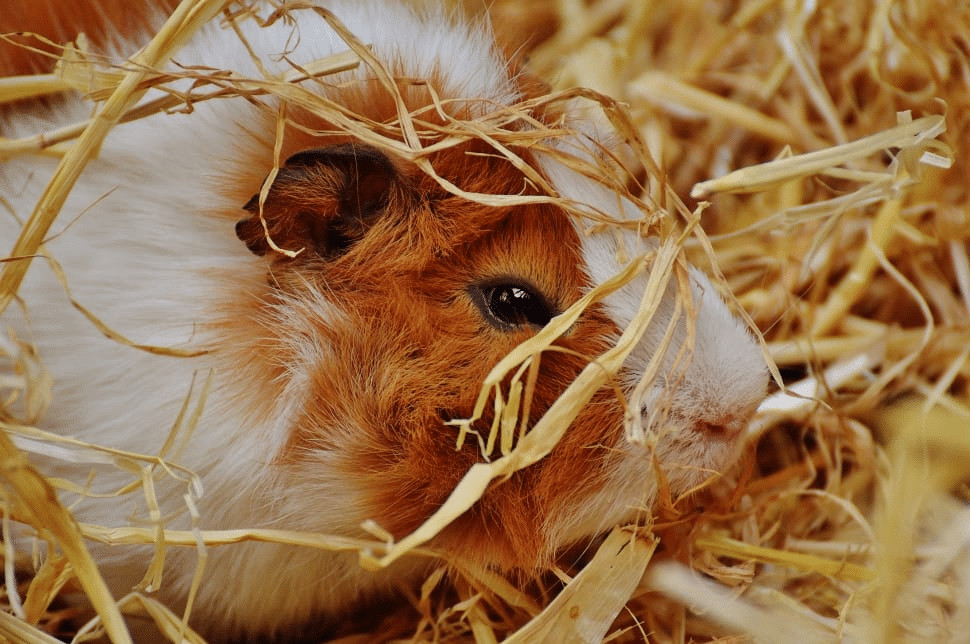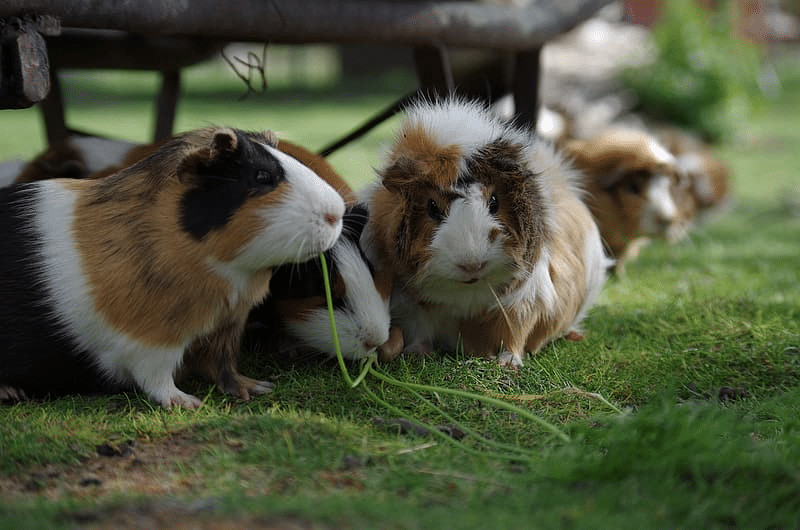Are you bringing a guinea pig home soon? How prepared are you for the big day? Your new little companion is going to need a hutch, as well as a whole lot of other essentials to make it feel at home.
To help you, we have put together a guide on how to set up a guinea pig hutch From choosing the right cage, bedding and accessories, to where to put the hutch, we have got you covered.
Let’s jump straight in with how to choose the right cage.
1. Choose a Guinea Pig Cage
Make sure the cage is the right size
Size definitely matters when it comes to choosing a cage for your guinea pig. And the bigger, the better. Remember, cavies need lots of space to run around and explore, so make sure the hutch is the recommended size.
Decide on the kind of cage
There are different types of cages, so you need to decide which one will be best for your guinea pig.
- Hutches – if you are keeping your guinea pig outside, then a hutch is what you are after. These provide guinea pigs with all the space they need for running around, as well as separate areas where they can sleep, eat and relax. Our hutches are manufactured in the UK using high-quality materials, and they are spacious and easy to clean.
- Wired cages – wired cages are also a good option if you plan on keeping your guinea pig indoors. It is important to remember, however, that the ready to buy wired cages you often see in pet stores are better suited to smaller pets, such as mice, hamsters and rats. Also, avoid cages with wire bottoms. Guinea pigs have very sensitive feet, and a wire-bottom cage could result in pododermatitis or bumblefoot as it is more commonly known.
- Aquariums/glass tanks – although glass tanks and aquariums were once considered a good cage choice for guinea pigs, we now know this is no longer the case. Cavies are prone to overheat, and as you can imagine, a glass tank doesn’t provide adequate ventilation or circulation of air. They are also not big enough.
2. Bedding Dos and Don’ts
The type of bedding you use can have a direct impact on your guinea pig’s health. Take a look at our dos and don’ts for choosing the best bedding for your cavy.
Do use wood or hay bedding
If you want to use wood bedding, the best options are aspen, softwood or hay. Make sure that the product has been dust-extracted and that the wood you choose has no natural aromas. Hay is particularly good as it helps control odours, is absorbent and 100% natural.
Do use fleece
You can also use fleece as bedding for your guinea pig’s cage. It absorbs moisture and will keep your guinea pig warm. Just bear in mind that this type of bedding will need to be cleaned more often, and could be a little on the expensive side to keep replacing.
Do use paper bedding
Paper bedding is a great option too. It is gentle on your guinea pig’s sensitive feet, it absorbs liquid and is cost-effective. The only downside to this kind of bedding is that the absorbed urine tends to smell stronger, and lingers a lot longer than hay or wood.
Don’t use pine or cedar wood shavings
Aromatic wood, such as pine and cedar, contain oils that can lead to respiratory problems in your guinea pigs. It is best to avoid these, and other fragranced woods to keep your cavy healthy.
Don’t use corn cobs
Avoid using corn cob bedding for your guinea pig. Not only is this hard on a cavy’s feet, but it can also become mouldy and lead to respiratory illnesses.
Don’t use sawdust
Never use sawdust near your guinea pig. The dust can cause allergic reactions or more serious respiratory issues.
Don’t use straw
Straw is not suitable to use as bedding because it is too hard and often sharp. Not only can this cause your guinea pig a lot of discomfort, but it can also result in eye injuries. Unlike the recommended bedding types, straw is not as absorbent.
Don’t only use newspaper
Although newspaper can be used to line the bottom of your guinea pig’s cage, it should never be used on its own as bedding. It doesn’t effectively absorb liquid, and it isn’t particularly comfortable.
3. Make Sure You Have All The Essentials
Making sure your guinea pig is happy and healthy requires more than just a cage and bedding. Before your pet moves into its new home, there are a few essential items you need.
Get a food bowl
Depending on how many guinea pigs you have, you will probably need a few food bowls. And remember the extra containers for fruit and vegetable snacks.

Get a water bottle or a bowl
Make sure your cavy has access to plenty of water throughout the day. We recommend water bottles, as they can’t be knocked over and the water stays fresher and cleaner for longer. Bowls are handy, but they can get dirty quickly, and there is a very good chance of liquid being spilt all over the hutch.
Place bridges and shelters around the hutch
Guinea pigs, by their very nature, are prey animals and need places where they can hide and feel safe. Providing your pet with little houses, lounging logs and huts is a great way to keep it mentally and physically stimulated, while also giving it plenty of space to relax.
Toys are always welcome
Toys are an affordable and fun way to keep your guinea pig active and encourage more exercise. They also help combat boredom, loneliness and depression. Take a look at our guidelines for choosing the best guinea pig toys and accessories that are safe and pet-friendly.

- Chew toys don’t only beat the boredom blues, but they also keep your guinea pig’s teeth short and healthy.
- Activity tunnels, tubes and pop-up tents promote movement mental stimulation.
- Avoid toys that can be dangerous. For example, wooden toys might splinter, while others could be a choking hazard.
- Never buy exercise balls or wheels. These toys are designed for hamsters, rats and mice and can cause your guinea pigs serious spine injuries.
Stock up on cleaning products
To keep your guinea pig healthy, you need to make sure its cage is as clean as possible. Stock up on disinfectant sprays that are safe to use around guinea pigs, as well as bin bags, cloths, scoops and lots of hay.
Get grooming products
Some guinea pig breeds will need additional grooming. Long-haired cavies, for example, will need to be brushed and clipped regularly. You will also need to trim their toenails, so clippers should be a part of your arsenal.
4. Setting Up the Hutch
You have the hutch, bedding as well as all the essential toys and accessories. Now it’s time to set up your guinea pig’s home.
Find a suitable location
Make sure the hutch is out of direct sunlight. To keep your guinea pigs warm and dry, it should also have a waterproof and insulated cover. Guinea pigs need plenty of ventilation, and their cage shouldn’t be placed anywhere that is too hot or too cold. To keep your cavy safe, check that the hutch is predator-proof and that it isn’t put directly on the ground.
Line the hutch
We suggest lining it with newspapers first. This will protect the bottom of the hutch and makes cleaning the cage easier too. Add the hay or wood shavings on top of the newspaper, making sure there is extra hay for your cavy to burrow and dig. Lots of hay in the sleeping areas will help keep your guinea pigs warm at night.
Create a food and water station
Depending on how many guinea pigs you have, and how big the hutch is, you will need to create one or more food and water stations. We like water bottles because they can be attached to the wire bars of the hutch, and you don’t need to worry about them being knocked over. If you opt for a water bowl, place it away from the food, and ensure pellets are kept in a separate container to fruit and veggie treats.
Place shelters around the hutch
Not only does your pet need plenty of space to run and play, but it also needs shelters and hidey holes where it can feel safe should something or someone frighten it. These little huts are also perfect for keeping your guinea pig cool in hot weather, and warm when the temperatures drop.
Provide plenty of hay
Guinea pigs don’t only like to eat hay, they also love playing in it. Make sure the hutch is filled with plenty of it so that your guinea pigs can hide, burrow, pull it out and even sleep in it.

Don’t forget a ramp
A ramp is pretty much your guinea pig’s stairway to freedom, food and independence. To keep your pet safe while using it, check that it isn’t too steep and that it has a good grip. Ramps with juts are especially useful as they help your cavy grip better when running up and down.
5 Top Tips When it Comes to Setting Up a Guinea Pig’s Hutch
While you are setting up a hutch for your guinea pigs, keep these top tips handy.

1. Never put your guinea pig’s hutch in a garage, or shed
These buildings can quickly become too hot or too cold for your cavy, or be too humid. Garages with cars or motorbikes in them will produce fumes that are potentially toxic to your pet.
2. Do not put your guinea pigs in an aquarium or a cage with a wire bottom
The best outdoor hutches for guinea pigs are made from high-quality wood, with mesh for ventilation. Never house your pet in a glass enclosure or a cage with a wire bottom. Aquariums restrict airflow, while wire bottom cages can injure your guinea pig’s feet.
3. Only use newspaper to line the bottom of the hutch
We recommend using newspaper to line the floor of the cage. However, you should never use it as bedding on its own. It is not absorbent enough and gets wet quickly. Not only will odours linger longer, but it could also cause all sorts of health issues for your guinea pig.
4. Make sure the hutch is predator-proof
To keep your guinea pigs safe from predators, you need to ensure the cage is made from strong, high-quality wood and mesh that will keep unwanted guests out.
5. Guinea pigs are not like other small rodents
Guinea pigs might be small, but they are not like hamsters, mice or rats. They shouldn’t be housed in cages that are too small, wire cages, or have exercise wheels or balls.
Following these guidelines will help you set up the perfect enclosure for your guinea pigs. But, should you have any questions at all related to this article, feel free to leave a comment below, and we will do our best to answer it.
For more advice and tips on keeping a happy cavy take a look at our guinea pig library.

















Im planning on getting 2 piggies in the spring – ive chosen a 6ft 2 tier hutch. Ive read that a lot of people usw fleece blankets to line the cage with some woodchips and hay. Is this a good lining for the hutch?